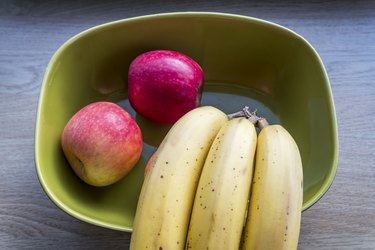
Is an apple or banana healthier? After all, these beloved fruits are popular among all ages and fit into most diets. However, if you're trying to cut calories, it's important to get the most nutritional bang for your buck.
Banana Versus Apple Nutrition Facts
Video of the Day
Eating a banana or apple in the morning will fuel your body and provide the energy needed to function at your peak. Both fruits contain simple and complex carbs as well as large doses of vitamin C, potassium, magnesium and phytochemicals. Apples, for example, provide the following nutrients per serving (about 8.5 ounces):
Video of the Day
- 126 calories
- 0.6 grams of protein
- 33.4 grams of carbs
- 5.8 grams of fiber
- 25.1 grams of sugars
- 0.4 grams of fat
- 7 percent of the DV (daily value) of copper
- 6 percent of the DV of potassium
- 4 percent of the DV of manganese
- 3 percent of the DV of magnesium
- 12 percent of the DV of vitamin C
- 1 percent of the DV of vitamin A
- 4 percent of the DV of vitamin K
- 70.2 micrograms of lutein and zeaxanthin
- 65.3 micrograms of beta-carotene
These delicious fruits are also rich in beta-cryptoxanthin and B-complex vitamins. A single serving provides more than 23 percent of the daily recommended fiber intake. Furthermore, apples contain polyphenols that may improve gut composition, lipid metabolism and cardiovascular health, according to a May 2015 review published in Nutrients.
Bananas are a powerhouse of nutrition, too. Each serving (4.4 ounces) delivers the following micro- and macro-nutrients:
- 112 calories
- 1.4 grams of protein
- 28.8 grams of carbs
- 3.3 grams of fiber
- 15.4 grams of sugars
- 0.4 grams of fat
- 11 percent of the DV of copper
- 10 percent of the DV of potassium
- 15 percent of the DV of manganese
- 8 percent of the DV of magnesium
- 12 percent of the DV of vitamin C
- 1 percent of the DV of vitamin K
- 27.7 micrograms of lutein and zeaxanthin
- 32.8 micrograms of beta-carotene
Like apples and most fruits, bananas boast high antioxidant levels. They're particularly rich in phenolic compounds and carotenoids, such as lycopene and beta-carotene. These phytonutrients exhibit anti-inflammatory, antimicrobial, hepatoprotective, cardioprotective and lipid-lowering properties, as noted in a November 2018 research paper featured in Food Quality and Safety.
What's Better: Apple or Banana?
If you compare apple and banana, you'll see that there are significant differences between the two. While both fruits are healthy, bananas have a higher nutritional value.
First of all, one serving of an apple is double in size compared to one serving of a banana. Yet, a banana packs more magnesium, potassium, zinc, selenium and other nutrients. The downside is that it has more calories and carbs per ounce. Apples, on the other hand, are higher in vitamin A, vitamin E, lutein, zeaxanthin and carotenoids.
The American Heart Association (AHA) and other health organizations recommend eating four servings of fruits per day. One medium fruit equals one serving. When you're on a diet, though, you want to keep an eye on your calorie intake. Bananas provide more nutrients per calorie than do apples. The key is to stick to the recommended serving size.
Both fruits are quite high in carbs and sugars. However, this doesn't necessarily mean that they promote weight gain.
According to a review published in Nutrients in October 2014, fruits facilitate weight loss and may prevent obesity despite their sugar content. These nutrient-dense foods alter the gut microbiota, suppress appetite and help reduce your calorie intake, making it easier to eat clean.
Why Eat Apples and Bananas?
The old saying "An apple a day keeps the doctor away" may hold some truth. According to the review published in Nutrients in May 2015, these fruits have been linked to a lower risk of chronic diseases. Fiber and polyphenols may be responsible for their potential health benefits.
Apple pectin, for example, may reduce triglycerides and cholesterol levels, protecting against cardiac events. The polyphenols in this fruit have been shown to reduce visceral fat mass, total fat and blood pressure, although more research is needed to confirm these findings. Furthermore, apple consumption may lower your risk of colorectal and bladder cancers, obesity, diabetes and premature death, reports a September 2016 review featured in the EXCLI Journal.
Bananas are just as beneficial. Rich in phenolic compounds, these fruits can improve your antioxidant status, reduce cancer risk and lower "bad" cholesterol levels, points out Food Quality Safety. Quercetin, a polyphenol in bananas, supports cardiovascular health. Gallic acid protects the liver, while ferulic acid may help decrease inflammation, ward off allergies and protect against cancer.
Based on these findings, it's hard to choose a winner in the banana versus apple debate. The good news is, you can enjoy both fruits as part of a balanced diet without worrying about your waistline. Just remember to consume them in moderation.
- USDA: "Nutrition Facts for Apples"
- Nutrients: "Apples and Cardiovascular Health — Is the Gut Microbiota a Core Consideration?"
- USDA: "Nutrition Facts for Bananas"
- Food Quality and Safety: "Bioactive Compounds in Banana Fruits and Their Health Benefits"
- American Heart Association: "Fruits and Vegetables Serving Sizes"
- Obesity: "Paradoxical Effects of Fruit on Obesity"
- EXCLI Journal: "Apple as a Source of Dietary Phytonutrients: An Update on the Potential Health Benefits of Apple"